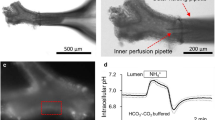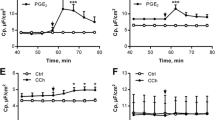Summary
Canine tracheal epithelium secretes Cl from the submucosal to the mucosal surface via an electrogenic transport process that appears to apply to a wide variety of secretory epithelia. Cl exit across the apical membrane is thought to be a passive, electrically conductive process. To examine the cellular mechanism of Cl secretion we studied the effect of anthracene-9-carboxylic acid (9-AC), an agent known to inhibit the Cl conductance of muscle membrane. When added to the mucosal solution, 9-AC rapidly and reversibly decreases short-circuit current and transepithelial conductance, reflecting a reduction in electrogenic Cl secretion. The inhibition is concentration-dependent and 9-AC does not appear to compete with Cl for the transport process. The decrease in current and conductance results from a decrease in the net and both unidirectional transepithelial Cl fluxes without substantial alterations of Na fluxes. Furthermore, 9-AC specifically inhibits a Cl conductance: tissues bathed in Cl-free solutions showed no response to 9-AC. Likewise, when the rate of secretion and Cl conductance were minimized with indomethacin, addition of 9-AC did not alter transepithelial conductance. In contrast, neither removal of Na from the media nor blockade of the apical Na conductance with amiloride prevented a 9-AC-induced decrease in transepithelial conductance. We also found that the effect of 9-AC is independent of transepithelial transport: 9-AC decreases transepithelial conductance despite inhibition of Cl secretion with ouabain or furosemide. Intracellular electrophysiologic techniques were used to localize the effect of 9-AC to a reduction of the electrical conductance of the apical cell membrane: 9-AC hyperpolarizes the electrical potential difference across the apical membrane and decreases its relative conductance. 9-AC also prevents the characteristic changes in the cellular electrical potential profile, transepithelial conductance, and the ratio of membrane conductances produced by a reduction in mucosal bathing solution Cl concentration. These results indicate that 9-AC inhibits Cl secretion in tracheal epithelium by blocking an electrically conductive Cl exit step in the apical cell membrane. Thus, they support a cellular model of Cl secretion in which Cl leaves the cell across a Cl permeable apical membrane driven by its electrochemical gradient.
Similar content being viewed by others
References
Al-Bazzaz, F.J., Al-Awqati, Q. 1979. Interaction between sodium and chloride transport in canine tracheal mucosa.J. Appl. Physiol. 46: 111–119
Al-Bazzaz, F., Yadava, V.P., Westenfelder, C. 1981. Modification of Na and Cl transport in canine tracheal mucosa by protaglandins.Am. J. Physiol. 240: F101-F105
Bryant, S.H., Morales-Aguilera, A. 1971. Chloride conductance in normal and myotonic muscle fibres and the action of monocarboxylic aromatic acids.J. Physiol. (London) 219: 367–383
Hayward, B.S., Barchi, R.L. 1980. Chloride efflux measurements in mammalian skeletal muscle.Muscle Nerve 3: 207–215
Levitan, H., Barker, J.L. 1972. Salicylate: A structure-activity study of its effects on membrane permeability.Science 176: 1423–1425
Olver, R.E., Davis, B., Marin, M.G., Nadel, J.A. 1975. Active transport of Na+ and Cl− across the canine tracheal epitheliumin vitro.Am. Rev. Respir. Dis. 112: 811–815
Palade, P.T., Barchi, R.L. 1977. On the inhibition of muscle membrane chloride conductance by aromatic carboxylic acids.J. Gen. Physiol. 69: 879–896
Shorofsky, S.R., Field, M., Fozzard, H.A. 1983. Electrophysiology of Cl secretion in canine trachea.J. Membrane Biol. 72: 105–115
Smith, P.L., Frizzell, R.A. 1982. Changes in intracellular K activities after stimulation of Cl secretion in canine tracheal epithelium.Chest 81: 5
Smith, P.L., Welsh, M.J., Stoff, J.S., Frizzell, R.A. 1982. Chloride secretion by canine tracheal epithelium: I. Role of intracellular cAMP levels.J. Membrane Biol. 70: 217–226
Welsh, M.J. 1983a. Evidence for basolateral membrane potassium conductance in canine tracheal epithelium.Am. J. Physiol. 244: C377-C384
Welsh, M.J. 1983b. Inhibition of chloride secretion by furosemide in canine tracheal epithelium.J. Membrane Biol. 71: 219–226
Welsh, M.J. 1983c. Intracellular chloride activities in canine tracheal epithelium: Direct evidence for sodium-coupled intracellular chloride accumulation in a chloride secreting epithelium.J. Clin. Invest. 71: 1392–1401
Welsh, M.J. 1983d. Intracellular potassum activities in canine tracheal epithelium.Am. J. Physiol. 14: C248-C254
Welsh, M.J., Smith, P.L., Frizzell, R.A. 1982. Chloride secretion by canine tracheal epithelium: II. The cellular electrical potential profile.J. Membrane Biol. 70: 227–238
Welsh, M.J., Smith, P.L., Frizzell, R.A. 1983. Chloride secretion by canine tracheal epithelium: III. Membrane resistances and electromotive forces.J. Membrane Biol. 71: 209–218
Welsh, M.J., Widdicombe, J.H., 1980. Pathways of ion movement in the canine tracheal epithelium.Am. J. Physiol. 239: F215-F221
Widdicombe, J.H., Ueki, I.F., Bruderman, I., Nadel, J.A. 1979. The effects of sodium substitution and ouabain on ion transport by dog tracheal epithelium.Am. Rev. Respir. Dis. 120: 385–392
Widdicombe, J.H., Welsh, M.J. 1980. Ion transport by dog tracheal epithelium.Fed. Proc. 39: 3062–3066
Author information
Authors and Affiliations
Rights and permissions
About this article
Cite this article
Welsh, M.J. Anthracene-9-carboxylic acid inhibits an apical membrane, chloride conductance in canine tracheal epithelium. J. Membrain Biol. 78, 61–71 (1984). https://doi.org/10.1007/BF01872533
Received:
Revised:
Issue Date:
DOI: https://doi.org/10.1007/BF01872533




